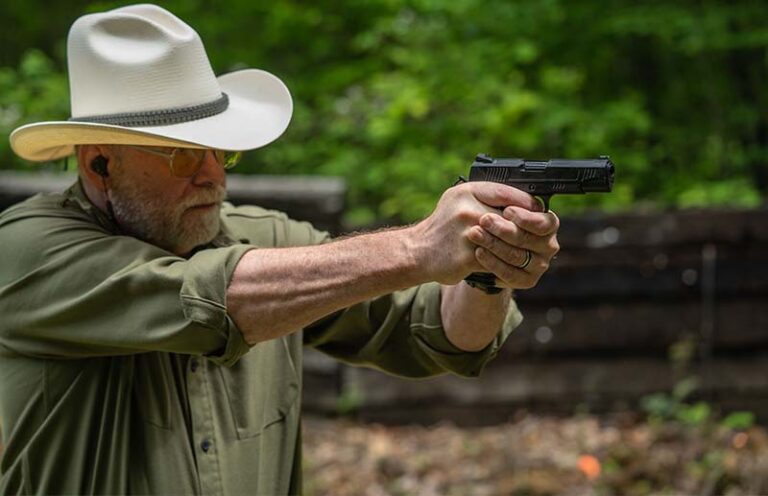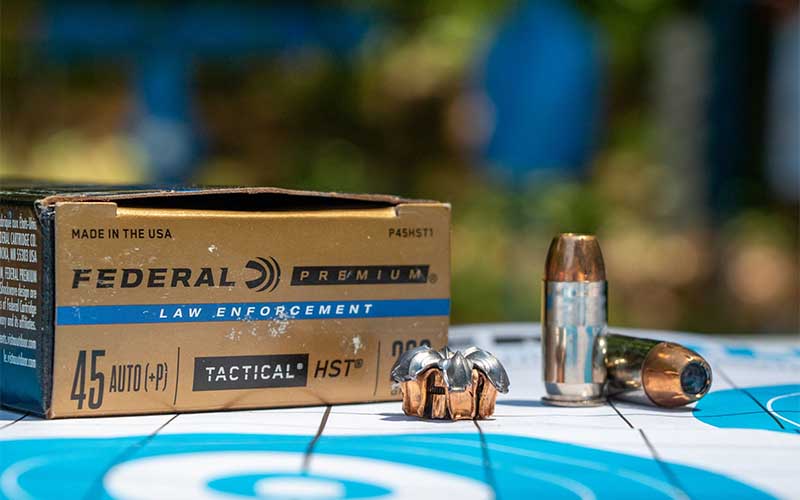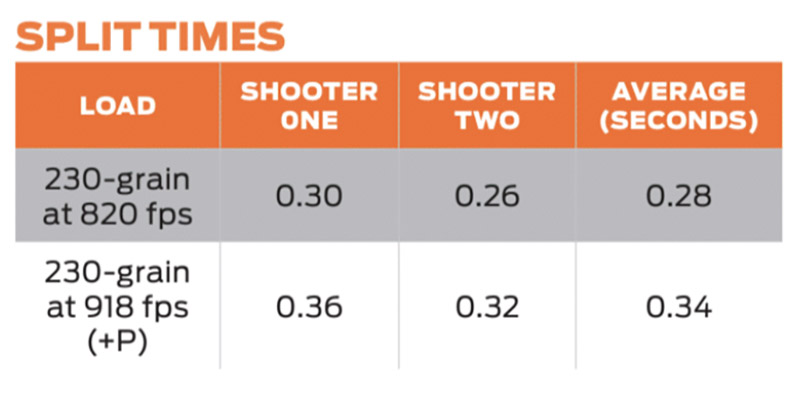
A brief discussion on handgun recoil and how it impacts your shooting.
Handgun recoil can be measured objectively. The free recoil energy in foot-pounds can be calculated with a mathematical formula. According to SAAMI (Small Arms and Ammunition Manufacturers’ Institute) the formula looks like this:
FRE = (WF/64.34) × (WEVE + WPCVPG)/7,000WF)²
- FRE = Free Recoil Energy in foot-pounds
- WF = Weight of the firearm in pounds
- WE = Weight of the bullet in grains
- VE = Velocity of the bullet in feet per second
- WPC = Weight of the propellant charge in grains
- VPG = Velocity of the propellant gases in feet per second
There’s also a modifier that’s applied to the velocity of the propellant gases (VPG) based on whether you’re calculating for rifles (VPG x 1.75), or shotguns and handguns (VPG × 1.50). You can use this formula if you like, but it’s quite silly. There are numerous online recoil calculators where you just input the required data and an answer is magically given. While I’ve found the results of various calculators/websites to disagree, it’s all relative and you’ll get a good idea of how hard a handgun might kick.

The problem with all of this is that recoil is a very subjective thing. Some associates and I were recently shooting a rifle that I found to have overly offensive recoil for a .308 Winchester. The other three shooters thought it was on par with .308 Winchester rifles of the same style and weight. These variations in perceived recoil apply to handguns as well. Because our hands are different, because we all have varying levels of strengths and because the grips of some handguns are shaped differently, there can be staunch disagreements on how hard this or that handgun feels to different individuals.
For a shooter, it’s important that a handgun is comfortable to shoot. The reasons should be obvious: The more comfortable a handgun is to shoot, the more you’ll shoot it. And the less a handgun recoils, the more accurate your shots will likely be, and the faster you should be able to make them.
I know, that’s a lot of math and gibberish to go through just to simply state that the more perceived recoil you feel from a handgun, the harder it is to shoot. However, now you have the math.
The real question is this: How much does handgun recoil impact your shooting?
In other words, if you’re shooting multiple shots, fast—which is something often required with a defensive handgun—how much does more recoil increase your split times? (Split times being the time between your shots.) Just as felt recoil might be different for everyone, it’s also possible that its impact on individual shooting performance will be different as well.

The Handgun Recoil Test
To get an idea of how recoil can negatively impact shooting, a friend and I conducted a test. We fired a variety of multi-shot defensive drills using a lightweight .45 Auto pistol loaded with standard and +P ammunition. We recorded the time between every shot, so that in the end we could analyze the data scientifically to see how much the harder recoiling load was to shoot compared to the lighter recoiling load. We only counted the runs where we had no misses. Our goal wasn’t to see how fast we could miss, but to see how fast we could hit.
Before sharing the results, you should know that when the standard pressure load was subjected to the recoil formula supplied in this article, it registered a Free Recoil Energy of 7.52 foot-pounds. When the +P load data was put into the formula, it was calculated to have 9.42 foot-pounds of Free Recoil Energy.
For what it’s worth, one online recoil calculator agreed with these results and another listed recoil energies of 8.77 and 10.72 foot-pounds, respectively. The results were different but proportionally mostly the same. Maybe more important was the fact that my friend and I both felt that out of the lightweight handgun, the +P load kicked like an SOB compared to the standard pressure load.

The results were interesting and provided at right for each load and each shooter. Going from the standard pressure to the +P load, I experienced an increase in my split times—the time between shots on multi-shot drills—of 0.06 second. That’s an increase of 20 percent. Interestingly, my assistant experienced an increase of the exact same amount of time.
One of the reasons I think this is interesting is that my assistant shot a little faster than I did; his split times were 0.04-second faster with both loads, but the +P load had more of a detrimental impact on his shooting than it did with me. Yes, he shot the +P load almost as fast as I shot the standard pressure load, but the +P load increased his split times by 23 percent … as opposed to 20 percent.
Split Times

So, what does all this shooting and all this math mean. For us, it meant that, on average, our split times increased very similarly to the increase in recoil. From a practical standpoint, this makes perfect sense. If your handgun generates 25 percent more recoil with one load, you can expect your split times to increase by a similar percentage.
This is for sure something to keep in mind when selecting ammunition. You might get better terminal performance with one load, but the increase in recoil might not be worth the reduction in the shootability of your handgun.
Editor's Note: This article originally appeared in the October 2022 issue of Gun Digest the Magazine.
More On Defensive Handgun Skills:
- Video: Target Transition Training With The Dot Drill
- The Shot Timer And Defensive Handgun Training
- Gun Digest’s 10 Best Shooting Drills And Firearms Training Posts
- MantisX: Simple And Effective Training
- Video: Is A Full-Sized Pistol The Best Training Option?

Next Step: Get your FREE Printable Target Pack
Enhance your shooting precision with our 62 MOA Targets, perfect for rifles and handguns. Crafted in collaboration with Storm Tactical for accuracy and versatility.
Subscribe to the Gun Digest email newsletter and get your downloadable target pack sent straight to your inbox. Stay updated with the latest firearms info in the industry.

![Best Concealed Carry Guns In 2025 [Field Tested] Wilson Combat EDC X9S 1](https://gundigest.com/wp-content/uploads/Wilson-Combat-EDC-X9S-1-324x160.jpg)


![Best 9mm Carbine: Affordable PCCs [Tested] Ruger Carbine Shooting](https://gundigest.com/wp-content/uploads/Ruger-Carbine-Shooting-100x70.jpg)
![Best AR-15: Top Options Available Today [Field Tested] Harrington and Richardson PSA XM177E2 feature](https://gundigest.com/wp-content/uploads/Harrington-and-Richardson-PSA-XM177E2-feature-100x70.jpg)

Well all of this is just fine for reading. My reading gave me many things to think about regarding kick from pistols and Revolvers. Generally speaking what I have learned and read is the PSI rating of the chamber of a gun when fired is the source of kick. Sure the weight of a pistol can make it feel less or more depending on a persons arm and hand strength but the PSI remains the same. I can shoot a 45 1911 and empty a clip in seconds and not leave the target. My 9mm is not so kind. It’s kicks the following rounds high and left. My 38 special has no kick at all, just a pop, much like a LR 22. My 380 is closer to my 9mm because of it being a small frame, something else people have to consider. All in all I am a shot placement person. I won’t shoot without a reason and a clear target and when I do I expect my practice of shooting poker chips will be a benefit. I aim for the head/eye. Even a near miss will disable most any person you hit. Body shots are no good for a crank head or PCP flyer. Head shots never fail if you do indeed hit the head. I’m sticking with my 38 special as a back up and moving forward in getting a large metal fram 45 for open carry. Great article but for many too much numbers and not enough plain talk. But still a great article.